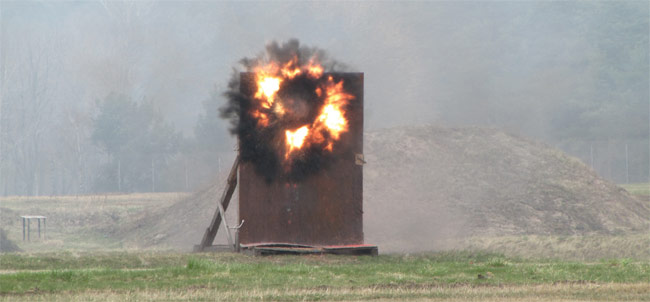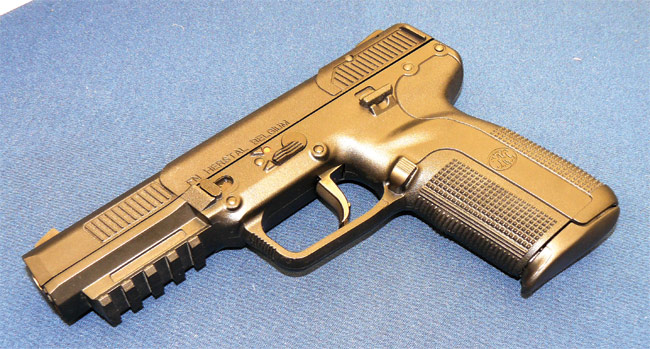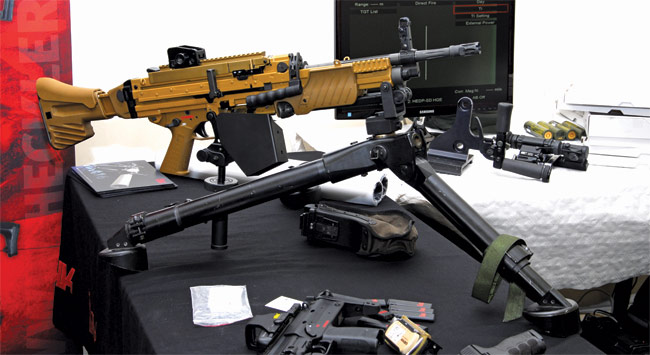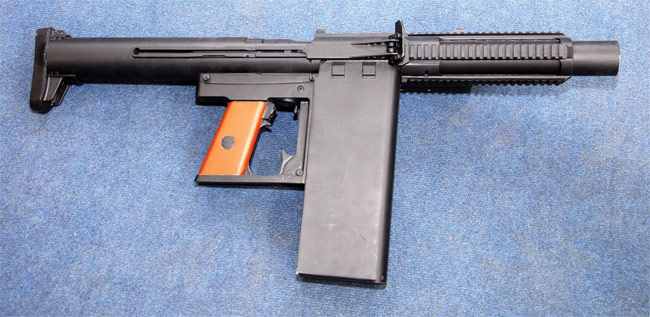ABOVE: The new HK417A2 needs a few burrs removed – like the right side bolt catch that can’t be activated manually.
On April 24-25, 2013 the Fourth Rheinmetall Infantry Symposium was held in Unterlüß, Lower Saxony, Germany. Once again it was organized by Rheinmetall Defence’s division of Rheinmetall Weapons and Ammunition. SADJ was there with about two dozen defense media writers invited from three continents.
This year’s Symposium gathered over 200 participants from several countries, mostly European NATO members and neutral countries (Swiss and Sweden), but some more exotic locations were also represented, including Azerbaijan and Kazakhstan. Many participants were in full dress in their military uniforms, including as many as three generals. The main fare of the Symposium was of course Rheinmetall Defence products, discussed in lectures and displayed in both static and dynamic exhibitions. Other exhibitors included Dynamit Nobel Defence, FN Herstal, General Dynamics, Haix, Heckler & Koch, MEN, Oakley, Rhode & Schwarz, RUAG, Schmidt & Bender, Simunitions 3M/Peltor and Vinghøg.
Over a day and a half of the bi-annual Symposium the participants had an opportunity to hear close to two dozen lectures on a wide range of infantry-themed subjects: from “Improving Explosive Effects Of Dismounted Infantry Firepower,” to “trends in 40mm grenade launchers and ammunition,” to current and future state of shoulder-fired infantry weapons, to operational experiences from Afghanistan and handing over control from ISAF to local government. The Symposium roster was – traditionally – a bit Bazooka/Mortar/Grenade Launcher – heavy, but a static display was a chance to get some hands-on knowledge of lighter stuff, including a brand-new and displayed close-up for the first time Rheinmetall RMG .50 cal. chain gun, hitherto shown only from a distance – and even that through a veil of camouflage netting. Again, demonstrations and lectures about the German Infantryman of the Future (IdZ – Infanterist der Zunkunft, internally at Rheinmetall called the Gladius program) were conspicuously absent – even though numerous elements were displayed at the static exhibition.
The presentations and lectures were delivered in English to avoid translation, by both the company reps and the ‘end users’, i.e. military personnel from several countries. All were fully relaxed, keeping healthy distance and exhibiting sometimes contagious, and often self-ironic humor. The epitome of that style was a presentation of ‘Operational realities’ or Afghanistan ‘lessons learned’ by the deceptively boyish-looking Capt. Robert Grant of 4 SCOTS, British Army, recounting the finer points of several operations performed by his regiment. It was maybe not even the core lecture that enthused the audience, (which was delivered in a concise, matter-of-fact militarily way, and studded with hard-earned bits of wisdom – transferring in just 15 minutes more valuable information than some other lecturers took three times longer to convey), but the aftermath – that being a slide show of snapshots from the combat tour, some being an embodiment of the famous British sense of humor.
Pictures From the Exhibition
The main star of the show, except of course of the hosts, was Heckler & Koch, whose display was the largest and most frequently besieged. The main points of interest were new models of their flagship infantry carbines: the HK416A5 and HK417A2. The new 416s and 417s do sport a redesigned (front turning knob) gas valve and integral fully ambidextrous controls, in fashionable Flat Dark Earth hard anodizing (internally known at the company as ‘The American Finish’). The 416/417 gas system is of the self-regulating type, initiated by the G36, and the gas-valve is only used for running with a suppressor – other than that (when the valve is set to ‘S’ for Suppressed) it remains always at ‘N’ for Normal.
The ambi-416/417s were mere prototypes and they will still go through modifications – but rather of petty nature, perhaps the right-side bolt carrier hold-open lever would be replaced with one enabling the manual activation for a chamber check, as the present version has a shelf underneath, precluding that and makes the unfortunate south-paw end-user switch to the other side in order to hold the bolt open manually.
Other already known models were displayed at the HK stand as well, mostly with some small modifications or in arcane configurations, hard to get hands-on when delivered to the target ‘black’ unit. These included a G36 with a RIS-style four rail aluminum handguard, similar to the 416, and a STANAG-compatible ambidextrous magazine well for the G36. A STANAG-compatible 30-round all polymer translucent magazine was on hand, as well as a new rendition of the G36 magazine without the stacking interfaces on the sides – long whined-over by the end-users for wasting space in a magazine pouch and catching on everything precisely while one is in a dire need of a fast reload.
There was also a big display of the newest HK GPMG, the 7.62-mm HK121, shown with an almost complete set of extras, including spare barrels of different lengths and weights, foregip/extending bipod for Special Forces, several types of butt-stocks (including turret gun spade grips), and a co-ax set (bobbed pistol grip with solenoid trigger and the longer, bull barrel – absent).
The older (though looking like a kid brother in comparison) 5.56mm sibling of the HK121, the MG4 machine gun was also displayed, mounted on the small-arms Vinghøg Buffermount. Other firearms displayed were the P30 pistol with a huge selection of exchangeable grip panels, enabling a tailored grip for every conceivable hand, and the HK GLM side-opening 40mm LV grenade launcher tube with alternative stand-alone kit.
The neighboring Rheinmetall stand offered a wide selection of grenades and mortar bombs, as well as several firearms. The most interest-gathering of these was the MG3 KWS, a modernized, ‘tacticool’ variant of the venerable MG3 GPMG, with a totally new shoulder stock (with adjustable cheek piece, shoulder rest and adjustable rear monopod). Other than that, the weapon has a redesigned fire control group with swiveling safety/selector lever (instead of MG 42 style push-rod), enabling semiautomatic firing, and is fitted with an electronic shot counter. Of course today no weapon can do without Picatinny rails: one was placed on top of the barrel shroud, the other in tandem with it on top of the receiver cover, and a short accessory rail was placed on the left front of the barrel shroud. This latter is asymmetrical because of the barrel changing slot extending along the entire right side of the shroud precluded fitting another on the right front. The 50-round belt is fed from polymer drum magazines (made by HK) during during transfers. This almost 70 years old machine gun is still used by many armies who might possibly be interested in a facelift modernization – even though the Bundeswehr seems poised to switch from the MG3 to the new MG5; being the HK121.
Another version of the new 40mm Medium Velocity grenade launcher were the semiautomatic Hydra and single shot Cerberus as presented by Rheinmetall. The 40mm MV concept (100 mps initial velocity) is intended to span the range gap between the 40mm LV and HV, being used in hand-held launchers.
Fire Control Systems for automatic grenade launchers were also on display, including the most advanced Vingmate FCS. The latest edition, displayed in Unterlüß, was fitted with a new thermal camera. It was displayed with the HK GMG, but also with two rarely seen AGLs, the American General Dynamics Striker Mk47 and South African Denel Vektor Y3.
Heavier exhibits were displayed at the outdoors display, including the Vinghøg Ring Mount for smaller ACs and APCs. The VRM is a sort of power-operated turret protected by Level 1 or 2 (optional) sides, with additional back protection provided by the hatch lid. The main armament cradle with a proper adapter can take a 40mm automatic grenade launcher or a machine gun (5.56mm SAW, 7.62mm GPMG or .50 cal. HMG). Vertical arc of fire is –15 to +50°, all around. Top frame takes camouflage netting or sun shade. The complete set weighs in at 250 kg (with Level 1 protection).
The Rheinmetal RLS RMG 50 heavy machine gun was also displayed outside, as a part of the Dual FEWAS remote controlled weapon station. Other then the elusive German chain gun with reciprocating barrel and bolt (sort of XM312-esque, but MUCH more compact), the weapon station was armed with two RGW 90 (Matador) shoulder fired recoilless anti-tank launchers by Dynamit Nobel Defence. The turret sports an optoelectronic observation and sighting suite, consisting of day-light CCTV, uncooled thermal camera and laser (IR) rangefinder. The optical suit and armament are the only components of the system not protected by armor. There are two control sets provided, for gun-layer and commander, the vertical arc of fire is –20° to +60°. The main weapon list covers most machine guns or automatic grenade launchers known to mankind at the present date – provided mounted with a proper adapter. So far only DND RWS 90 AT launchers are supported by the DUAL Fewas – but of course The Customer Is Always Right, and proper adapters can be devised for most other systems, should the buyer prefer them to the Matadors.
FN Herstal showed their usual display, of which a most interesting and practical blooper-tube FCU 1.5M sighting module and modernized FiveseveN Mk 2 pistol is worthy of a note. The ‘new’ FiveseveN has a solid (hitherto two-part) slide with metal sights, and controls would now be made out of black, instead light gray plastic. Hardly revolutionary changes.
Personal equipment from the Gladius program (known in the German Army as the IdZ, Future Infantryman) were on display, including the electronics, sighting equipment, integrated load bearing vest, the cooling vest and uniform – but the item drawing most curious onlookers were undoubtedly the…ballistic knickers! That was a combat underwear with integrated ballistic protection for the soldier’s groin. But the issue here transcends the ease of mind of a grunt – it’s mostly for added protection of the massive blood vessels nearby, mainly the femoral arteries. Hits severing one of these are known to have killed many soldiers within minutes. The garment is of course made out of thermo-active, breathable, moisture wicking technical fabrics with antibacterial characteristics to boot.
Firing Demonstrations
The most flashy part of the Infantry Symposium are day and night firing demonstrations. The night demo is unfortunately not much more than an opportunity to see flares light occasionally punctuated by arcing tracers. If you’re more into grey-greenish shadows, the hosts have provided a TV display showing the range in NV. During daytime you may actually see what is firing what, where from and where to – although from a distance that is deemed safe by the organizers.
One can see live firing of the various flash-bangs, smoke grenades, hand grenades – including the Air Burst Hand Grenade, which works like hand-thrown version of the WW2 Bouncing Betty mine. After the grenade is thrown, narrow spring steel supports deploy, righting the grenade upon fall. Then a lifting charge is fired, separating the fragmentation unit from the base and throwing the pre-fragmented main unit – being actually a proper grenade – about 1m (3 ft) high, whereas it detonates, extending the kill zone in comparison with other ground-detonating ones.

This year a demonstration of the Fly-K Silent Mortar was finally held. Functionally, the Fly-K is a reincarnation of the spigot mortar – like the WW2 British Blacker Bombard or PIAT – with looks of a Japanese Type 89 ‘Knee Mortar.’ The mortar bomb (looking rather like a rifle grenade) is being impaled upon the spigot inside the cup-like barrel part of the mortar. Inside the spigot there is a Double-Action-Only trigger mechanism, firing the propelling charge inside the grenade. The bomb itself is on the light side (approx. 0.8 kg), so a charge to propel it to 800 meters isn’t exactly large. Thanks to that, at mere 100 meters from the firing position the measured report is just 54 dB! This could be corroborated on the spot – from a camera pit 50 meters distant from the Fly-K position, we witnessed the demo with earmuffs removed. The brochures were right – it really is as loud as a champagne pop or clap of your hands. Moreover, the day-time demo enabled the mortar to show its mettle – shattering the old adage, that a mortar is a high-angle-only weapon. This mortar can be fired Line of Sight – but of course at a much shorter distance. Anyway, in a pinch it’s definitely better to have a weapon able to fire bombs LOS at 200-300 meters, than not to have one at all. The Special Forces potential of the Fly-K is obvious, enabling massed surprise bombardment of enemy positions. With a practical rate of fire within 12-16 rpm range, this weapon is hardly audible at 100 meters, while sending bombs to 800 meters. Before the first bomb impacts on target 800 meters apart, the crew would be able to pop 6 bombs and scoot to another location to renew bombardment.
Another demonstration was held of the programmable 40mm HV ammunition – and again, it was impressive. Two 5-round bursts from an HK GMG fitted with the Vinghøg Vingmate FCS produced 10 airbursts at precisely the same spot, that is, 1 meter over the roof of a target automobile at 500 meters. That’s impressive accuracy, and you could see dozens of small holes pierced in both the automobile and wooden witness silhouettes located around. Most of these fragments would have been intercepted by body armor or helmet, but there were enough of these to find some unprotected spot and do damage.
After the demo was finished, guests were invited to acquire hands-on time experience with HK and FN small arms, including the grenade launchers. Not much to relate there, except for the FN rep’s ballet, who had to single-load the Minimi, because German safety regulations precluded anyone but Rheinmetall personnel to go fully automatic, despite a) firing from a reinforced cubicle with no way to impart a shot anywhere except down range, and b) most of the audience being active service military personnel trained to use machine guns. The HK stand just substituted the machinegun with another 416 rifle, and were ready to go.

On the other end of the firing line 40mm LV grenade launchers were used, fitted with automated sighting modules, provided by both HK and FN. The Heckler and Koch table offered the AG-HK416b slung under the HK416 fitted with the FelVIS. This a rectangular block the size of two cigarette boxes with an Aimpoint T1 precariously perched on top, clinging for dear life from the left side rail of the RIS-style forend. A cable with pressure plate switch goes from the box to the pistol grip. The shooter aligns the red dot with the target and presses the switch, while keeping the dot spot-on. The target is thus lazed and distance is measured, with data sent to a ballistic computer inside the box. On release of pressure, the firing solution worked out by the computer is executed, whereas the whole box tilts around the horizontal axis to an angle, re-aligning the red dot with the target would set proper elevation to send the grenade to the point of aim. An additional display underneath shows if the rifle is set vertically. With red dot on target and a cant display on vertical, you should hit the target upon squeezing the trigger. Despite scant and accidental experience with a grenade launcher, I was able to achieve a direct hit at a 300 meters target with second shot – but it took way too long for a combat scenario. The sighting module changes the weapon’s center of gravity (all the weight is on one side), sticks out of the weapon (a hard-knock magnet of unbelievable proportions), and can be vulnerable to both battlefield debris or abuse. The most annoying thing about it however, was the need to focus the eyesight at the same instant both on target 300 meters apart and a canting indicator right in front of one’s face. The low-tech solution was obvious to us within 10 seconds – use a sight displaying a cross reticle not a dot and discard the canting sensor.
Which is exactly what the designer of the FN FCU 1.5M grenade launcher sight module did. The Belgian sight was fitted on EGLM module of the SCAR platform, here used in a stand-alone mode. The cubic capacity of the FN sight is probably the same as the HK unit, but it is straddling the centerline, so it doesn’t cant the whole thing. Also, the sensor unit, collimating sight and ballistic computer are built into a fixed box – nothing here moves outside. The operation is the same as its Teutonic competitor: sight, press, release, elevate the rifle until aligned with the reticle, hold breath, press trigger and pray. The only additional display shows distance readout, and you don’t need it all to aim the weapon properly. It is useful, however, if you wrongly mark the target: I was aiming at 200 meters, while the display flashed ‘105’ and I immediately knew something is wrong. Another measurement was point on, and I was good to go then. Now the FN sight has a large cross, almost European # 4 hunting reticle, which is a built-in low-tech canting sensor. Even if the ground is uneven, and you can’t trust the horizontal line, you just keep the vertical on, and it still does the trick. You only got one sight picture to hold, no additional displays to help you lose the focus. And the result was a rewarding sight of an (almost) headshot with a 40mm grenade at 200 meters!











